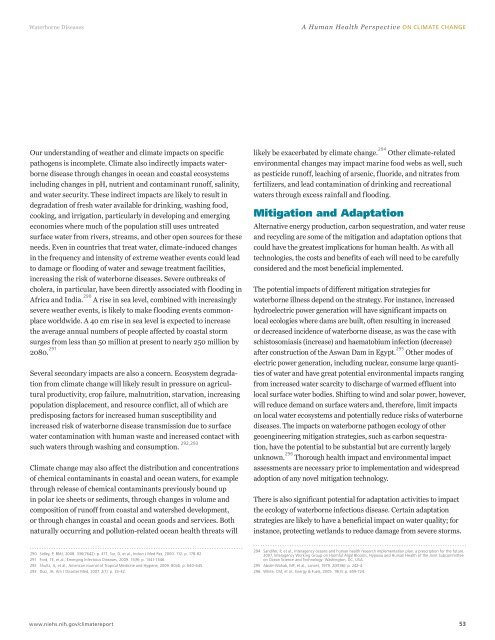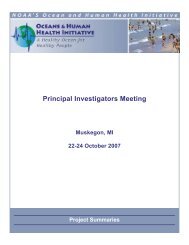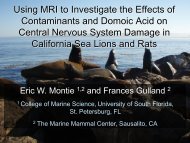A Human Health Perspective On Climate Change - The Oceans and ...
A Human Health Perspective On Climate Change - The Oceans and ...
A Human Health Perspective On Climate Change - The Oceans and ...
Create successful ePaper yourself
Turn your PDF publications into a flip-book with our unique Google optimized e-Paper software.
Waterborne DiseasesA <strong>Human</strong> <strong>Health</strong> <strong>Perspective</strong> ON CLIMATE CHANGEOur underst<strong>and</strong>ing of weather <strong>and</strong> climate impacts on specificpathogens is incomplete. <strong>Climate</strong> also indirectly impacts waterbornedisease through changes in ocean <strong>and</strong> coastal ecosystemsincluding changes in pH, nutrient <strong>and</strong> contaminant runoff, salinity,<strong>and</strong> water security. <strong>The</strong>se indirect impacts are likely to result indegradation of fresh water available for drinking, washing food,cooking, <strong>and</strong> irrigation, particularly in developing <strong>and</strong> emergingeconomies where much of the population still uses untreatedsurface water from rivers, streams, <strong>and</strong> other open sources for theseneeds. Even in countries that treat water, climate-induced changesin the frequency <strong>and</strong> intensity of extreme weather events could leadto damage or flooding of water <strong>and</strong> sewage treatment facilities,increasing the risk of waterborne diseases. Severe outbreaks ofcholera, in particular, have been directly associated with flooding inAfrica <strong>and</strong> India. 290 A rise in sea level, combined with increasinglysevere weather events, is likely to make flooding events commonplaceworldwide. A 40 cm rise in sea level is expected to increasethe average annual numbers of people affected by coastal stormsurges from less than 50 million at present to nearly 250 million by2080. 291Several secondary impacts are also a concern. Ecosystem degradationfrom climate change will likely result in pressure on agriculturalproductivity, crop failure, malnutrition, starvation, increasingpopulation displacement, <strong>and</strong> resource conflict, all of which arepredisposing factors for increased human susceptibility <strong>and</strong>increased risk of waterborne disease transmission due to surfacewater contamination with human waste <strong>and</strong> increased contact withsuch waters through washing <strong>and</strong> consumption. 292,293<strong>Climate</strong> change may also affect the distribution <strong>and</strong> concentrationsof chemical contaminants in coastal <strong>and</strong> ocean waters, for examplethrough release of chemical contaminants previously bound upin polar ice sheets or sediments, through changes in volume <strong>and</strong>composition of runoff from coastal <strong>and</strong> watershed development,or through changes in coastal <strong>and</strong> ocean goods <strong>and</strong> services. Bothnaturally occurring <strong>and</strong> pollution-related ocean health threats willlikely be exacerbated by climate change. 294 Other climate-relatedenvironmental changes may impact marine food webs as well, suchas pesticide runoff, leaching of arsenic, fluoride, <strong>and</strong> nitrates fromfertilizers, <strong>and</strong> lead contamination of drinking <strong>and</strong> recreationalwaters through excess rainfall <strong>and</strong> flooding.Mitigation <strong>and</strong> AdaptationAlternative energy production, carbon sequestration, <strong>and</strong> water reuse<strong>and</strong> recycling are some of the mitigation <strong>and</strong> adaptation options thatcould have the greatest implications for human health. As with alltechnologies, the costs <strong>and</strong> benefits of each will need to be carefullyconsidered <strong>and</strong> the most beneficial implemented.<strong>The</strong> potential impacts of different mitigation strategies forwaterborne illness depend on the strategy. For instance, increasedhydroelectric power generation will have significant impacts onlocal ecologies where dams are built, often resulting in increasedor decreased incidence of waterborne disease, as was the case withschistosomiasis (increase) <strong>and</strong> haematobium infection (decrease)after construction of the Aswan Dam in Egypt. 295 Other modes ofelectric power generation, including nuclear, consume large quantitiesof water <strong>and</strong> have great potential environmental impacts rangingfrom increased water scarcity to discharge of warmed effluent intolocal surface water bodies. Shifting to wind <strong>and</strong> solar power, however,will reduce dem<strong>and</strong> on surface waters <strong>and</strong>, therefore, limit impactson local water ecosystems <strong>and</strong> potentially reduce risks of waterbornediseases. <strong>The</strong> impacts on waterborne pathogen ecology of othergeoengineering mitigation strategies, such as carbon sequestration,have the potential to be substantial but are currently largelyunknown. 296 Thorough health impact <strong>and</strong> environmental impactassessments are necessary prior to implementation <strong>and</strong> widespreadadoption of any novel mitigation technology.<strong>The</strong>re is also significant potential for adaptation activities to impactthe ecology of waterborne infectious disease. Certain adaptationstrategies are likely to have a beneficial impact on water quality; forinstance, protecting wetl<strong>and</strong>s to reduce damage from severe storms.290 Sidley, P, BMJ, 2008. 336(7642): p. 471, Sur, D, et al., Indian J Med Res, 2000. 112: p. 178-82.291 Ford, TE, et al., Emerging Infectious Diseases, 2009. 15(9): p. 1341-1346.292 Shultz, A, et al., American Journal of Tropical Medicine <strong>and</strong> Hygiene, 2009. 80(4): p. 640-645.293 Diaz, JH, Am J Disaster Med, 2007. 2(1): p. 33-42.294 S<strong>and</strong>ifer, P, et al., Interagency oceans <strong>and</strong> human health research implementation plan: a prescription for the future.2007, Interagency Working Group on Harmful Algal Blooms, Hypoxia <strong>and</strong> <strong>Human</strong> <strong>Health</strong> of the Joint Subcommitteeon Ocean Science <strong>and</strong> Technology: Washington, DC, USA.295 Abdel-Wahab, MF, et al., Lancet, 1979. 2(8136): p. 242-4.296 White, CM, et al., Energy & Fuels, 2005. 19(3): p. 659-724.www.niehs.nih.gov/climatereport 53










